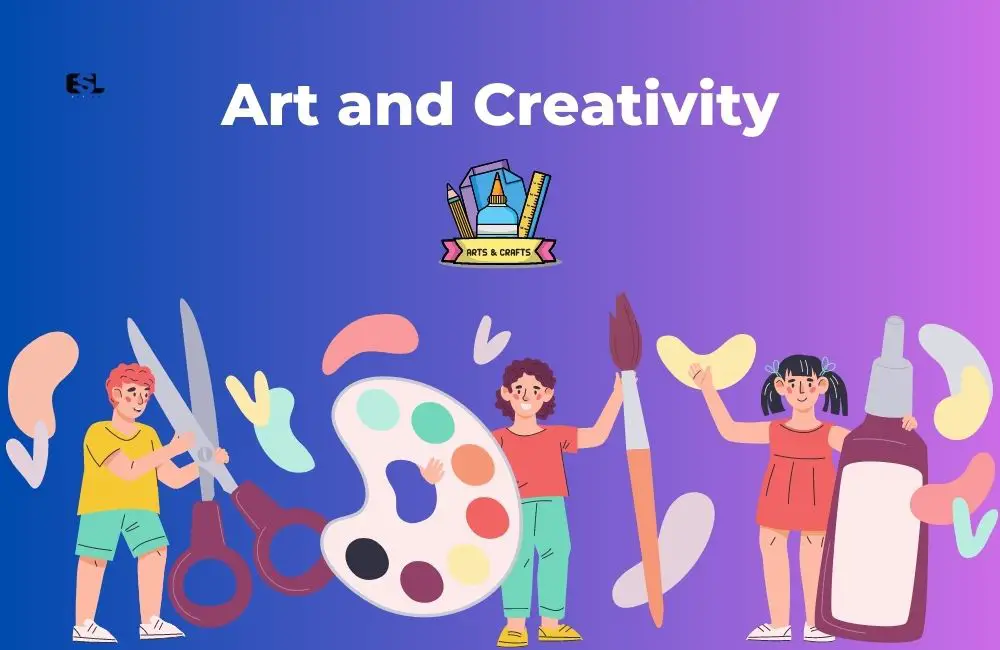Art is a universal language that communicates through aesthetics, color, and form, transcending boundaries and connecting cultures. However, understanding and discussing art can often be enhanced by solidly grasping the relevant vocabulary.
This article presents a selection of must-know words and phrases related to art and creativity. Whether you are an aspiring artist, a connoisseur, or simply interested in art appreciation, these terms can deepen your understanding and enable you to discuss art more fluently and confidently.
Table of Contents
- 1. Basic Art Terms
- 2. Art Movements and Styles
- 3. Artistic Techniques and Elements
- Sample Conversation: Using Vocabulary Related to Art and Creativity
- Conclusion
- FAQ: Vocabulary Related to Art and Creativity
1. Basic Art Terms
Art has its own language. Knowing the basic terminology can help you understand, appreciate, and discuss different art forms and styles.
| Word/Phrase | Meaning/Usage | Example Sentences |
|---|---|---|
| Medium | The material or technique an artist uses to create a work of art | “Oil paint is a traditional artistic medium.” |
| Composition | The arrangement of elements within a work of art | “The composition of the painting draws the viewer’s eye to the central figure.” |
| Perspective | A technique used to represent three-dimensional objects on a two-dimensional surface | “Renaissance artists developed the techniques of linear perspective.” |
| Abstract | Art that does not attempt to represent an accurate depiction of visual reality | “Abstract art often relies on colors and forms to convey emotion.” |
| Realism | Art that seeks to represent subject matter truthfully, without artificiality | “Realism emerged as a response to the idealized images of romanticism.” |
| Aesthetic | Pertaining to the appreciation of beauty or good taste | “The aesthetic of minimalist art focuses on simplicity and clean lines.” |
| Palette | The range of colors used by an artist | “Van Gogh is known for his bright and expressive palette.” |
| Texture | The perceived surface quality in a work of art | “The texture of the sculpture gives it a lifelike quality.” |
| Tone | The lightness or darkness of colors | “Using different tones, the artist created a sense of depth.” |
| Proportion | The relationship in size of one part to another | “Correct proportions are important in portraiture.” |
If you are searching for an effective English language vocabulary builder, try Word Power Made Easy: The Complete Handbook for Building a Superior Vocabulary (Amazon Link). This time-tested classic has helped millions achieve mastery of English and improve their communication skills in business, the classroom, and in life.
2. Art Movements and Styles
Throughout history, art has evolved and taken on new forms. Different art movements and styles carry their own philosophies and methodologies.
| Word/Phrase | Meaning/Usage | Example Sentences |
|---|---|---|
| Impressionism | An art movement known for its emphasis on capturing the fleeting effects of light and color | “Monet is a famous impressionist painter.” |
| Cubism | An early 20th-century style of art, pioneered by Picasso and Braque, characterized by multiple viewpoints | “Cubism broke from traditional perspectives in art.” |
| Surrealism | An art movement that sought to channel the unconscious to unlock the power of the imagination | “Salvador Dalí is a well-known surrealist artist.” |
| Pop Art | An art movement that emerged in the 1950s and used imagery from popular culture | “Andy Warhol is famous for his pop art depictions of Campbell’s soup cans.” |
| Minimalism | An art style characterized by simplicity and a focus on the essentials | “Minimalist art often uses basic shapes and a limited color palette.” |
| Expressionism | An art movement that emphasizes the emotional and psychological expression of the artist | “Edvard Munch’s ‘The Scream’ is an iconic work of expressionism.” |
| Dada | An early 20th-century art movement that ridiculed contemporary culture and traditional art forms | “Dada art often used absurdity and randomness as a protest against the brutality of World War I.” |
| Renaissance | A period in European history marked by a renewed interest in the arts, learning, and sciences | “The Renaissance produced such artists as Leonardo da Vinci and Michelangelo.” |
| Baroque | An art style of the 17th century characterized by complex forms, bold ornamentation, and contrasting elements | “Baroque art is known for its dramatic, often theatrical, presentation.” |
| Romanticism | An art movement that emphasized emotion, individualism, and nature | “Romanticism was a reaction against the industrial revolution and the Enlightenment.” |
3. Artistic Techniques and Elements
Artistic techniques are the methods and materials used to create works of art. Understanding these terms can provide insights into an artwork’s creation and the skill required.
| Word/Phrase | Meaning/Usage | Example Sentences |
|---|---|---|
| Chiaroscuro | A technique that uses strong tonal contrasts between light and dark to model three-dimensional forms | “Caravaggio is known for his dramatic use of chiaroscuro.” |
| Fresco | A technique of mural painting executed upon freshly laid lime plaster | “Michelangelo’s ceiling in the Sistine Chapel is a famous example of fresco.” |
| Collage | An art technique where the artwork is made from an assemblage of different forms | “Collage can include a variety of materials, such as paper, photographs, and fabric.” |
| Impasto | A technique used in painting, where paint is laid on an area of the surface very thickly | “Van Gogh’s paintings are known for their bold impasto brushwork.” |
| Pointillism | A technique of painting in which small, distinct dots of color are applied in patterns to form an image | “George Seurat is famous for developing pointillism.” |
| Stencil | A sheet of material with a design cut out of it, used to produce the design on the surface beneath by applying pigment through the cut-out holes | “Street artists often use stencils for their work.” |
| Etching | A printmaking technique that uses chemical action to produce incised lines in a metal printing plate which then hold the applied ink and form the image | “Rembrandt was known for his mastery of etching.” |
| Glaze | In painting, a thin, transparent layer of paint | “Artists often use glazes to achieve depth and luminosity.” |
| Gesso | A white paint mixture used in artwork as a preparatory layer for many mediums including oils and acrylics | “Applying gesso to a canvas helps to protect it and make colors appear more vibrant.” |
| Grisaille | A method of painting in gray monochrome, typically to imitate sculpture | “Grisaille was often used in the Renaissance for underpainting.” |
To elevate your vocabulary in just 30 days, I recommend to my students an informative, fun, and accessible guide to utilizing powerful language. Millions of individuals have enhanced their academics, job skills, and confidence by dedicating just fifteen minutes daily to the exercises and tests of 30 Days to a More Powerful Vocabulary (Amazon Link), a top-selling. It offers step-by-step methods to bolster language prowess, discover compelling words, and daily vocabulary enhancement with pronunciation guidance.
Sample Conversation: Using Vocabulary Related to Art and Creativity
Situation: At an art gallery opening, Lila and Daniel discuss various artworks and the creative processes behind them.
Lila: Daniel, have you seen the “abstract” piece in the center? The use of “texture” and “composition” is so intriguing.
Daniel: Yes, I was just admiring it. It’s fascinating how the artist played with “perspective” and “symmetry” to evoke emotions. There’s a strong sense of “dynamism” in it.
Lila: Absolutely. And look at that “sculpture” over there. The “contours” and “silhouette” are so lifelike. It’s a perfect blend of “realism” and “impressionism.”
Daniel: Art has such diverse “genres,” doesn’t it? From “surrealism” to “cubism,” the range of creative expression is boundless. By the way, have you tried any “digital art” techniques?
Lila: I have! I recently got into “graphic design” and have been experimenting with “digital painting.” It’s a fresh medium that offers so much flexibility.
Daniel: That’s wonderful! Whether it’s “canvas” or a “digital screen,” the canvas for creativity is vast. Art truly knows no bounds.
Conclusion
Learning the vocabulary related to art and creativity is an ongoing process, just as art itself continues to evolve. These terms provide foundational knowledge to help enhance your understanding, appreciation, and discussion of art in its myriad forms. Whether you’re exploring a museum, creating your own artwork, or simply wishing to understand the creative world a little better, these terms will help you on your journey.
FAQ: Vocabulary Related to Art and Creativity
1. What is “abstract” art?
“Abstract” art does not attempt to represent an accurate depiction of visual reality. Instead, it uses shapes, colors, and forms to achieve its effect.
2. How does “texture” enhance artwork?
“Texture” refers to the perceived surface quality in art. It can be both seen and felt, adding depth and dimension to a piece, making it more engaging.
3. What do artists mean by “composition”?
“Composition” is the arrangement of visual elements in an artwork. It determines how different elements work together to guide the viewer’s eye and convey the intended message.
4. How does “perspective” affect paintings?
“Perspective” gives a three-dimensional feeling to a flat image. It’s a technique that represents objects in relation to each other as they appear to the human eye, providing depth to the piece.
5. What’s the difference between “realism” and “impressionism”?
“Realism” aims to depict subjects as they appear in real life, without embellishment. “Impressionism,” on the other hand, captures the essence or impression of a scene, often using bold colors and visible brush strokes.
6. How has “digital art” evolved over the years?
“Digital art” uses digital technology as an essential part of the creative process. Over the years, it has evolved with advancements in technology, software, and tools, allowing artists to explore new mediums and techniques.
7. What role does “symmetry” play in artworks?
“Symmetry” refers to a balanced arrangement of elements, creating harmony and aesthetic appeal in an artwork.
8. What is “surrealism” in art?
“Surrealism” is an artistic movement that seeks to express the subconscious mind’s workings, often combining unrelated images or ideas in dreamlike settings.
9. How is “cubism” distinct from other art forms?
“Cubism” breaks objects down into geometric shapes and reassembles them, depicting subjects from multiple viewpoints. It challenges traditional techniques and perspectives.
10. Why is “graphic design” significant in today’s digital age?
“Graphic design” involves creating visual content to communicate messages. In today’s digital age, it plays a crucial role in branding, advertising, and conveying information effectively across various platforms.






